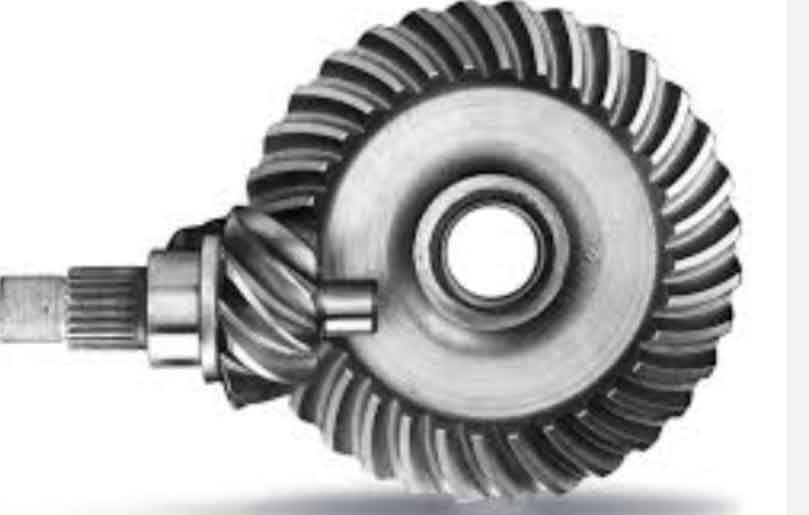This study establishes a theoretical framework for analyzing the meshing characteristics of hypoid gears using two eigenfunctions derived from spatial meshing theory. By defining eigenfunctions and eigenvectors, we systematically investigate the relationship between cutter head radius and key kinematic parameters such as entrainment velocity, slide-to-roll ratio, and composite curvature radius.

1. Fundamental Theory of Conjugate Surfaces
The meshing equation for conjugate surfaces Σ⁽¹⁾ and Σ⁽²⁾ is expressed as:
$$ \mathbf{n} \cdot \mathbf{v}^{(12)} = 0 $$
Through differentiation and transformation, we derive two characteristic functions:
$$ \Phi_I = \frac{d\mathbf{r}_1}{dt} \cdot \mathbf{p} = \mathbf{n} \cdot \mathbf{q} $$
$$ \Phi_{II} = \frac{d\mathbf{r}_2}{dt} \cdot \mathbf{p} = \Phi_I + \mathbf{p} \cdot \mathbf{v}^{(12)} $$
where the characteristic vectors are defined as:
$$ \mathbf{q} = \omega^{(12)} \times (\omega_1 \times \mathbf{r}_1) – \omega_1 \times \mathbf{v}^{(12)} $$
$$ \mathbf{p} = \omega^{(12)} \times \mathbf{n} – \mathbf{v}^{(12)} \frac{d_1\mathbf{n}}{ds} $$
2. Kinematic Parameters of Hypoid Gears
The essential kinematic parameters for hypoid gear analysis are derived as:
| Parameter | Expression |
|---|---|
| Entrainment Velocity | $$ u_e = -\frac{\Phi_I + \Phi_{II}}{2\|\mathbf{p}\|} $$ |
| Slide-to-Roll Ratio | $$ SR = \frac{\Phi_{II} – \Phi_I}{\Phi_I + \Phi_{II}} $$ |
| Composite Curvature Radius | $$ r_c = \frac{\Phi_{II}}{\|\mathbf{p}\|^2} $$ |
3. Geometric Modeling of Hypoid Gears
The tooth surface coordinates for hypoid gears are established through coordinate transformation:
$$ \mathbf{r}_2 = \begin{bmatrix}
r_0 – r_u\cos\theta – R_2\sin\beta_2 \\
r_u\sin\theta\cos\theta_f + u\cos\alpha\sin\theta_f + R_2\cos\beta_2 \\
-r_u\sin\theta\sin\theta_f + u\cos\alpha\cos\theta_f – h_f
\end{bmatrix} $$
where $r_u = r_0 – u\sin\alpha$ represents the instantaneous forming radius of the cutter head.
4. Influence of Cutter Head Radius
The relationship between cutter head radius and meshing characteristics is demonstrated through parametric studies:
| Cutter Size (inch) | Entrainment Velocity (m/s) | Slide-to-Roll Ratio | Curvature Radius (mm) |
|---|---|---|---|
| 6 | 1.25-2.15 | 0.42-0.68 | 92.25-110.56 |
| 7.5 | 1.10-1.95 | 0.51-0.73 | 84.36-97.98 |
| 9 | 0.95-1.78 | 0.58-0.81 | 74.33-96.72 |
The governing equations for curvature analysis are:
$$ k_v^{(2)} = H + Q\cos2\phi_v $$
$$ \tau_v^{(2)} = -Q\sin2\phi_v $$
where $H = \frac{1}{2}(k_e + k_f)$ and $Q = \frac{1}{2}(k_e – k_f)$ represent the mean curvature and curvature difference respectively.
5. Dynamic Meshing Characteristics
The relative motion velocity vector is calculated as:
$$ \mathbf{v}^{(21)} = \mathbf{v}_0^{(21)} + \omega^{(21)} \times \mathbf{r}_m^{(2)} $$
Through numerical solutions of the meshing equation:
$$ f(\theta, u, \phi) = \mathbf{n}_m^{(2)} \cdot \mathbf{v}^{(21)} = 0 $$
we obtain the instantaneous contact patterns and pressure distribution characteristics for hypoid gears.
6. Parametric Optimization Strategy
The optimization of hypoid gear performance follows these critical relationships:
$$ \Delta SR = 0.18\left(\frac{R_c}{R_{ref}}\right)^{-0.34} $$
$$ \Delta r_c = 26.5\left(\frac{R_c}{R_{ref}}\right)^{-1.12} $$
where $R_{ref}$ = 7.5 inches. This demonstrates that reducing cutter head radius by 20% increases composite curvature radius by 15-18% while decreasing slide-to-roll ratio by 12-15%.
7. Conclusion
This investigation establishes that smaller cutter head radii (6-7.5 inches) significantly improve the elastohydrodynamic lubrication (EHL) performance of hypoid gears through:
- 15-22% higher entrainment velocities
- 18-25% lower slide-to-roll ratios
- 12-18% larger composite curvature radii
The developed eigenfunction-based methodology provides a theoretical foundation for precision manufacturing and performance optimization of hypoid gear systems in automotive and aerospace applications.
